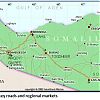Hide and skins trade in Somaliland

23 February 2017 - Terra Nuova, the International Livestock Research Institute (ILRI) in collaboration with IGAD Sheikh Technical veterinary School (ISTVS) and with funding from DANIDA under the LIVE[1] Programme are implementing a study to map the hides and skin value chain in Somaliland. The ultimate goal is to identify investment opportunities within this chain and communicate the results to relevant stakeholders.
The first phase of this study involved focus group discussions (FGDs) that was held with key informants (butchers, hides and skins collectors, tannery operators, exporters and government officials) in Hargeisa between May and July 2016. The purpose of the FGD was to conduct a preliminary mapping of the value chain including full identification of actors, their functions and linkages and also main constraints faced. Respondednts were drawn from major towns in Somaliland including Boroma, Gebiley, Hargeisa, Berbera, Burao, Las Anod and Erigavo (see image at the bottom of the page).
Findings from the FGDs confirmed the importance of hides (from cattle and camels) and skins (from sheep and goats) as an emerging export commodity for Somaliland. For example, in 2015, the country exported about 1,200MT of skins (dry and wet blue) and 700MT of hides (dry) to several countries including Pakistan, India, China and Turkey). The primary sources of these hides and skins included abattoirs (big slaughter houses), slaughter slabs and slaughter of animals by livestock keepers in their homesteads. Green i.e fresh) hides and skins were assembeled by 'colletors' and delivered to warehouse assemblers. From here, there were either wet-salted or dried. Warehouse assemblers, either sold their products to exporters, who exported the wet-salted or dry hides and skins or to processors (tanneries) who processed these to wet-blue.
Low quality products remained a major concern resulting in losses due to rejection of up to 30% of the merchandise. There is therefore need to invest in improvement of slaughter facilities and practices and skills of value chain actors including livestock producers and personnel involved in animal slaughter and flaying.
Wholesalers and tannery operators reported occasional inconsistencies that characterize decisions by regulatory ministries on running of businesses in the hides and skins industry, some which led to suspension or termination of operational lisences despite heavy investmsnts. This was noted to limit performance of the sector and increase uncertainties among investors. There is therefore need to develop a harmonized hides and skins industry policy which should serve to guide the activities of investors and decisions made by regulators.
Besides the policy constraints, traders complained about high costs and/or occasional unavailability of important inputs such as salt and chemicals used in leather tanning. There is need for efforts to address the concerns raised. In the case of salt, a possible intervention would be regulation of packaging in order to ensure that buyers always get a fair deal of what they purchase. To address the problem of shortage in salt supply, investors in the industry and also development actors should explore the possibility of introduction of salt recovery technologies such as those being used in tanneries in Ethiopia. Recovery and recycling of salt also renders the hides and skins industry more environmentally friendly.
In addition, there is need for an evaluation of the feasibility for more value addition of hides and skins within Somaliland before they are exported. It is especially important to note that the process of tanning raw hides and skins into wet blue is more costly in terms of pollution than the subsequent processes of processing wet blue to crud leather and also finished leather.
[1] Livestock Investment and Vocational Education Programme in Somalia


